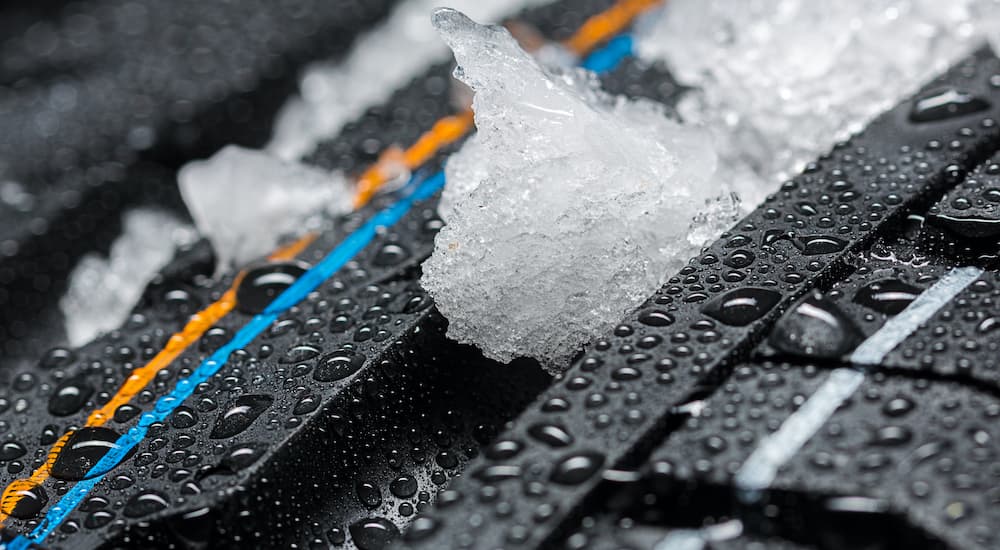Full disclosure: I’m a nerd. This is relevant because I like to learn about things like snow and winter tires or the differences between All-Wheel Drive and Four-Wheel Drive (there are some, but that’s not what we’re here for). Snow tires are essential for many drivers, but not everyone, and depending on where you grow up, they may or may not be part of your driving education. Someone who learns to drive in Southern California and then moves to Wisconsin is going to have a serious shock to the system when driving during their first winter there. Whether you grew up with them or not, you might have questions about snow tires, and I’m here with answers.
What are snow tires?
Snow tires, also called winter tires, are tires designed to be particularly effective and keep you in control as well as possible when the temperature drops and things get snowy. The way they are designed, the materials used, and other factors make them superior to other types of tires for dealing with snow, slush, ice, and winter weather. In particular, it’s worth noting that snow/winter tires are superior to all-season tires in winter; despite their name, these are best for spring through autumn unless you live somewhere particularly warm.
What makes snow tires special?
A few different aspects of snow tires make them better than other options for cold weather and snow, so let’s look at each of them. For starters, they’re designed with deep grooves, and lots of slots and sipes (tiny slits in the tire’s surface) are made to shovel snow and slush as you drive through it. The snow is scooped up and tossed out by these tires, allowing the tire surface to make better contact with the road and keep you in control in slippery conditions.
The second major thing that sets winter tires apart is the type of rubber used in them. In order for tires to work well, they need to deform and squash a bit to make better contact with the road while you drive – all tires are designed to do this, and it’s a key part of engineering the rubber they’re made from. The rubber used in all-season tires is excellent at this in a wide range of temperatures, but once it drops below 45 degrees, the rubber becomes harder and brittle, no longer able to easily squash and hug the road.
Winter and snow tires are made using rubber engineered to remain soft and pliable in low temperatures, even extremely low temperatures in some cases. The design means they will provide you with much better grip and traction even on dry roads if the temperature has dropped below 45 degrees, especially if that’s the average throughout the day for long periods. Even if you live somewhere that doesn’t get much snow, and if it’s particularly cold, you should use them during the winter.
When are snow tires necessary?
The answer to this is tied to the previous answer – whenever the average temperature is below 45 degrees for long stretches of time. The climate completely depends on where you live and where you’re driving for the most part: if you live in Texas and take a trip to Wisconsin for January and February, then you should slap some winter tires on your vehicle. You’ll need to look at your local weather to see what works for you, though many places with rough winters suggest using snow tires from mid-November to early April to be safe. This is good advice if you live somewhere like Shorewood, IL – where it’s below 45 on average from November through March, but not needed if you live in Phoenix, AZ, and the average doesn’t get below 55 degrees.
Do snow tires work with a sedan?
Yes, the type of vehicle you drive doesn’t impact whether you should use snow/winter tires – they’re great for any ride. Your tires are about control, vital for any vehicle, from a compact sedan to a full-size truck or SUV. Small vehicles can lose control on slushy roads just as easily as larger ones, sometimes even easier depending on what type of sedan you’re driving. It’s always important to have the right tires on your car throughout the year.
Do snow tires matter if I have All-Wheel Drive?
Yes, All-Wheel Drive (AWD) can help you maintain control in some situations, but you still need winter tires on them if you live somewhere that gets below 45 degrees on average for long periods throughout the year. AWD means that power goes to both sets of your vehicle’s wheels – whereas models with Front-Wheel Drive (FWD) only send power to the front wheels and those with Rear-Wheel Drive (RWD) only have the power go to the back wheels. AWD is great for dealing with gravel roads, mud, and other slippery conditions since it gives you a better chance of having your wheels grip and find traction.
AWD won’t help you stop any quicker in the winter than other drive types – but having snow tires on your vehicle can. Power going to all four wheels doesn’t matter if the tires on those wheels can’t get traction, which is why you need to have winter tires in good condition when dealing with snow and cold weather. One thing worth noting is that RWD is typically the worst option in winter conditions since powered wheels push them at the back of the vehicle – fishtailing is common with RWD and snow. FWD can be the best option in winter since the weight of the engine and drivetrain is above the power wheels, making it easier to get good traction.
What about snow chains?
Snow chains are entirely separate; they’re only needed if you live somewhere with severe winter weather. Snow chains are pretty much just what they sound like: a net of metal chains that you can wrap around your tires. These can dig into ice that other tires can’t break through or gain traction on, giving you superior control in rough conditions that include a lot of packed snow and ice.
There are two very big things to consider with snow chains. First, they’re not legal in all areas, so you need to know whether they’re allowed where you live or where you’re driving – some places that do allow them still have limits on when chains can be used. And second, if there isn’t a lot of ice and snow on the ground, traction with snow chains on can be absolutely terrible. They’re very dangerous on dry roads – plus snow chains can damage the road or your vehicle, especially when used at high speeds, so they’re not for the highway.
Are there different types of snow tires?
You’ll find a few different categories of snow tires, many of which are marketed for use in specific climates. The winter tires someone uses in Chicago might not work in extreme winter areas in Sweden or up in Alaska, so you’ll find tires rated for the lower temperatures drivers have to deal with. There are also studded winter tires, which have metal studs inserted into their surfaces during manufacturing; these studs can break up ice and heavy-packed snow on the road, making them great for roads that aren’t cleared quickly. Studded tires may also be restricted in some areas, so where you live should ultimately guide your decisions about whether you need snow tires, when to get them, and what kind to choose.






